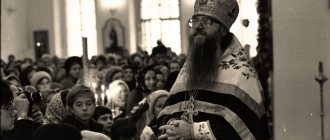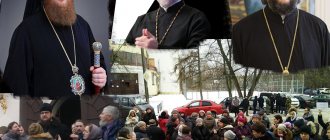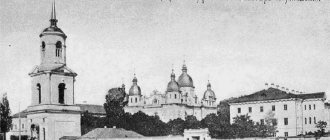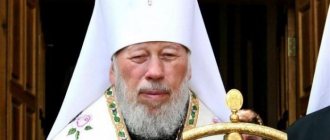Hieromartyr Kirill (Smirnov), Kazan, Metropolitan
Hieromartyr Kirill, Metropolitan of Kazan and Sviyazhsk (in the world Smirnov Konstantin Ilarionovich) was born into the family of a psalm-reader on April 26, 1863 in the city of Kronstadt, St. Petersburg province. In 1887, Konstantin graduated from the St. Petersburg Theological Academy with a candidate of theology degree. On November 21, 1887, he was ordained a priest and assigned to the Resurrection Church of the Temperance Society in St. Petersburg, while simultaneously serving as a teacher of the law at the Elisavetpol gymnasium and the 2nd gymnasium in St. Petersburg. Since 1900, Father Konstantin was appointed to the position of rector of the Kronstadt Holy Trinity Cemetery Church. The priest served in the priesthood for 15 years. The unexpected death of little Olga, who was dying painfully from a swallowed needle, followed by her wife, who did not survive the grief, prompted 38-year-old Father Konstantin to take monasticism in 1902. Soon he was appointed to the post of head of the Urmia Spiritual Mission in Persia and elevated to the rank of archimandrite. On August 6, 1904, Archimandrite Kirill was consecrated as Bishop of Gdov, vicar of the St. Petersburg diocese. Wanting the people to participate more fully in the divine service, Vladyka introduced popular singing during the divine service in the Alexander Nevsky Lavra. Before his death, the holy righteous John of Kronstadt asked that the funeral service be performed by the young Bishop Kirill, whom he knew from his service in Kronstadt. From 1908 to 1928, Vladyka ruled the Tambov and Shatsk diocese. He sought to travel as often as possible to the most remote places of his diocese for the sake of communicating with his flock. In 1913 he was elevated to the rank of archbishop. In 1914, through the labors of the Bishop, the glorification of St. Pitirim of Tambov took place (July 28). The strength of the Vladyka’s faith was manifested in the following episode: when, by order of the sanitary commission, in connection with the cholera epidemic in 1909, an order was given to consecrate only boiled water for Epiphany, the Vladyka refused to do this and blessed the river water. It is remarkable that this same conviction: “Everything that is not from faith is sin,” was also expressed in one of his last letters dated March 8, 1937. During the February events of 1917, Vladyka warned from the pulpit: “If we do not hold on to our past, we will write a page in our history that the next will read with shame on their faces, they will be ready to tear it out, but there are no scissors with which to to cut something out of the memory of history.” During the war, on the initiative of the Saint, fundraisers for the needs of the front, infirmaries at monasteries, shelters for children whose parents died, and various committees to help soldiers were organized. At the Local Council, Vladyka was nominated second among the initially elected 25 candidates for the Patriarchate. He was also elected a member of the Holy Synod under His Holiness Patriarch Tikhon. On March 19, 1918, the saint was appointed to the metropolitan see of Tiflis and Baku, as well as to the post of Exarch of the Caucasus, but he was unable to leave for his destination. In 1919, he was arrested in Moscow on charges of “counter-revolutionary agitation by sending out appeals and communicating with Kolchak and Denikin” and imprisoned by the V.Ch.K. In 1920, after his release, he was appointed to the Kazan and Sviyazhsk departments, but through month he was again arrested in Kazan on charges that he “left Moscow for Kazan without the permission of the V.Ch.K.” The ruler is sentenced to imprisonment in a camp for 5 years. In the Taganskaya Moscow prison he is in the same cell with the holy martyrs Archbishop Theodore (Pozdeevsky) and Bishop Gury (Stepanov). In 1921, he was released under an amnesty and Vladyka returned to Kazan, but in 1922 he was arrested again and, after imprisonment in a Moscow prison, exiled to Ust-Sysolsk (now Syktyvkar). In the Moscow prison he sat in the same cell with the Hieromartyr Thaddeus, Archbishop of Astrakhan (December 18). Together they wrote an appeal to believers about the “Living Church,” which they managed to send out throughout Russia. Then Vladyka is exiled to Ust-Kulom (Komi A.O.), where he is with Bishop Afanasy (Sakharov), and later he is transferred to the city of Kotelnichi, Vyatka region. There is information that from Ust-Kuloma, the head of the department of G.P.U.E.A. Tuchkov called Metropolitan Kirill to Moscow for negotiations, offering to “agree,” that is, to make compromises, but this attempt ended in failure for the authorities. In 1924, the Saint returned from exile and met in Moscow with St. Patriarch Tikhon, successfully convincing him to abandon reconciliation and cooperation with the renovationist V. Krasnitsky. G.P.U. imposed these actions on His Holiness, promising then to release the archpastors from prison. In response to these promises, the Bishop said to His Holiness: “Your Holiness, don’t think about us, the bishops. Now we are only fit for prisons...” Having heard this, His Holiness crossed out Krasnitsky’s name from the signed paper. From Moscow, Vladyka moved to Yelsk, then to Perervolok. By testamentary order of His Holiness Patriarch Tikhon dated December 25, 1924, he is appointed as the first candidate for the post of Patriarchal Locum Tenens. Soon the Saint was sent into exile again. For this reason, after the death of St. Patriarch Tikhon, he was unable to accept the position of Locum Tenens and the Hieromartyr Metropolitan Peter (Polyansky) became him. In 1926, the idea of secretly electing a Patriarch arose among the episcopate. Under the act of electing Metropolitan Kirill, whose term of exile was expiring, 72 episcopal signatures were collected (at that time there was only one for Metropolitan Sergius (Stragorodsky). Thus, Metropolitan Kirill was elected Patriarch, but his enthronement did not take place, since G.P. This action became known to U. Tuchkov, when the results of the vote became known to him, stated that he would allow the enthronement of Metropolitan Kirill to the Patriarchal Throne only on the condition that in the future he would follow his instructions when installing bishops. Vladyka replied, “Evgeniy Alekseevich, you - not a cannon, and I am not a projectile with which you hope to destroy the Russian Church." A wave of arrests soon followed. Vladyka Kirill, who was in exile, was arrested and imprisoned in the city of Vyatka. Vladyka was sentenced to an additional three years of exile and from April In 1927, he was sent to the camp of Khantayka, Turukhansky district, Krasnoyarsk district, and then to the city of Yeniseisk. After the release of the Declaration of Metropolitan Sergius in 1927, Vladyka separated from communication with him, since he did not want to participate in what his “conscience ... recognized as sinful” . In the Provisional Patriarchal Holy Synod approved by Metropolitan Sergius, he saw a threat to the integrity of the Patriarchal system and its replacement by collegial governance. In the administrative church activities of Metropolitan Sergius, Vladyka (like the Locum Tenens, Hieromartyr Metropolitan Peter (Polyansky)) saw an excess of the powers granted to him by the title of Deputy Locum Tenens, which led to a schism in the Church. The Bishop considered it senseless and harmful to preserve the central church authority at such a price. In conditions when the legal establishment of a central administrative-church power is impossible, and when it became clear that “Metropolitan Sergius rules the Church without the leadership of Metropolitan Peter,” he called for being guided by the decree of St. Patriarch Tikhon on November 20, 1920, according to which the bishops had to create local self-government and then, under more favorable conditions, report to the Council on their activities. From May to November 1929, Vladyka corresponded with Metropolitan Sergius, trying to convince him to abandon the disastrous path of compromise. These letters from the Lord, deeply thought out and clearly argued, reveal the spiritual and moral essence of the problem. Metropolitan Sergius responded with threats of canonical repression, demanding the preservation of church discipline. The Bishop, defending those who confessed their disagreement with the church course of the Deputy Locum Tenens, not wanting to “participate in what their conscience has recognized as sinful,” responds to this demand: “This confession is charged to them in violation of church discipline, but discipline is also capable of maintain its effectiveness only as long as it is an effective reflection of the hierarchical conscience of the conciliar Church, and discipline cannot replace this conscience in any way. As soon as it presents its demands not by virtue of the instructions of this conscience, but by motives alien to the Church or insincere, the individual hierarchical conscience will certainly stand guard over the conciliar-hierarchical principle of the existence of the Church, which is not at all the same thing with the external “unity in which come what may." In December 1929, Metropolitan Sergius brought the Saint before the court of bishops and dismissed him from the administration of the Kazan See. Since 1932, Vladyka was in exile in the Turukhansk region. For six months the night lasts here, interrupted only by the Northern Lights; for six months the inhabitants of this region are cut off from the whole world: no letters, no newspapers, no parcels. The frost reaches 60 degrees. The short polar summer and myriads of painful midge mosquitoes, scurvy, lack of basic necessities... This is the situation in exiles above the Arctic Circle... Here, many exiled bishops lived in small villages far from each other, so they could not see each other. Only with the Hieromartyr Bishop Damascus (Tsedrik) did Vladyka manage to communicate briefly, and from then on they became friends forever. After his release in August 1933, the Saint lived for a short time in the city of Gzhatsk. The like-minded clergy persistently asked the Saint to declare his rights and take upon himself the burden of governing the suffering Church. But Vladyka considered it impossible for himself to do this until he fully understood the situation that had arisen. In 1934, the Saint came to Moscow and appeared at the Patriarchate. The guard blocked his entrance, but the tall, once mighty Metropolitan, pushing him aside, stepped into the office of Metropolitan Sergius. A few moments later the Lord came out; Apparently, everything became clear to him. This was their last meeting. Soon, in the summer of 1934, he was arrested in Gzhatsk on charges of “counter-revolutionary activities” and imprisoned in the special-purpose internal detention center of the Butyrka prison in Moscow. The saint was sentenced to 3 years of exile, which he served in the village. Yany-Kurgan (South Kazakhstan region). Metropolitan Joseph (Petrovykh) lived nearby in the same exile, and the two metropolitan elders were consoled by at least some possibility of communication. “With Metropolitan Joseph,” wrote Vladyka, “I am in fraternal communication, gratefully appreciating the fact that with his blessing the first protest was expressed from the Petrograd diocese against the idea of Metropolitan Sergius and a warning was given to everyone in the impending danger.” The Bishop, according to his faithful follower-confessor Bishop Athanasius (Sakharov, commemorated October 15), allowed non-attendance to “Sergian” churches as a protest, but at the same time he condemned the blasphemy of unreasonable zealots against the services performed there. For himself, he allowed only in case of mortal need to confess to the “Sergius” priest. In one of his letters in 1929, the saint wrote: “The substitution of power committed by him (M. Sergius), of course, cannot be called a falling away from the Church, but this is undoubtedly the gravest sin of the fall. I will not call the perpetrators of sin graceless, but I will not participate in communion with them and I will not bless others, since I have no other way to expose a sinning brother.” He wrote directly to Metropolitan Sergius: “In its entirety, I attribute my abstinence only to you, but not to the ordinary clergy, and even less so to the laity. Among the ordinary clergy there are very few conscious ideologists of your church activities.” However, “for those who well understand the untruth existing in Sergianism,” Vladyka wrote in 1934, “... by their non-resistance to it, they reveal criminal indifference to the desecration of the Church.” But this soft position of the Saint hardened somewhat in the last years of his life, perhaps due to his communication in exile with the Hieromartyr Metropolitan Joseph (Petrovykh), as well as the fact that all the deadlines for waiting for Metropolitan Sergius to repent of the disastrous course of church policy had expired. On July 7, 1937, Vladyka was arrested in exile and imprisoned in the Shymkent prison. During the interrogation, where he was accused of “leading the entire counter-revolutionary clergy,” Vladyka behaved very courageously and took full responsibility for the investigation’s accusations. On November 6, he was convicted by the U.N.K.V.D. troika and sentenced to death. On November 7 (20 Art.), the saint was shot in the Fox ravine near Chimkent along with the holy martyrs Metropolitan Joseph (Petrovykh) and Bishop Evgeniy (Kobranov). Metropolitan Kirill is one of the most prominent hierarchs in the history of the Russian Orthodox Church. This archpastor of special spiritual strength was sent by the Lord in an era of unheard-of persecution, as an example of firmness in the confession of faith. He was an impeccable Saint, who combined the feat of prayer with active archpastoral activity, the dignity of a high rank with true simplicity, humility and love. In all places of the Lord’s ministry, his special gift is manifested: people are drawn to him, attracted by his spiritual beauty and unshakable faith. Canonized as the Holy New Martyrs and Confessors of Russia at the Jubilee Council of Bishops of the Russian Orthodox Church in August 2000 for church-wide veneration.
To Kazan via the Urals
However, before moving on to the answer to the question about the new status of the already former head of the Yekaterinburg Metropolis, we should say a little about his predecessor at the Kazan See - Metropolitan Feofan (Ashurkov) , who died on November 20 from coronavirus.
Metropolitan Feofan (Ashurkov)
Both bishops practically never crossed paths in their lives (except for joint events). The church career of Metropolitan Feofan can be roughly divided into two halves - until the early 2000s, the future bishop worked in various positions of church diplomacy. Including from 1993 to 1999, then Archimandrite Theophan held the post of the Department of External Church Relations, which at that time was headed by the future Patriarch Kirill.
In 2000, Archimandrite Feofan was elevated to the rank of bishop and sent to the Magadan diocese, which, under his leadership, quickly came to life. Here he is actively involved in the construction of new churches, organizing cultural and educational events and establishing contacts with local authorities. The same thing was observed after Bishop Feofan was transferred to the Stavropol Territory to the position of rector of the seminary in 2003.
In 2011, the bishop headed the Chelyabinsk diocese, where, already in the rank of metropolitan, he transformed it into a metropolitanate. By the way, at the same time, Metropolitan Kirill heads the Yekaterinburg diocese and also transforms it into a metropolis. Both Ural bishops are engaged in the construction and restoration of new churches in their territories.
Both metropolitans are establishing friendly ties with the governors. Metropolitan Kirill was able to strengthen relations with the governor of the Sverdlovsk region, Evgeny Kuyvashev . Metropolitan Feofan, in turn, became friends with the head of the Southern Urals, Mikhail Yurevich . A feature of the style of the Chelyabinsk bishop was a flexible policy when carrying out his own initiatives - in both the Magadan and Chelyabinsk regions, Feofan managed to introduce the basics of Orthodoxy to schools without a scandal.
However, already in 2014, the Chelyabinsk bishop headed the Simbirsk Metropolis , and a year later he was transferred to the Kazan See, which he occupied until his death at the age of 73.
To briefly summarize, we can note the common features between the deceased Metropolitan of Kazan and Tatarstan and his successor. Both bishops distinguished themselves by their activity in the construction of churches and the implementation of educational projects. And both metropolitans passed through the Urals.
Kazan: relegation or promotion?
Commenting on the new appointment of Metropolitan Kirill, both Reshetnikov and Perevezentsev unanimously believe that the transfer to Kazan testifies to Patriarch Kirill’s enormous trust in the head of the Yekaterinburg Metropolis.
Pyotr Reshetnikov regards this decision as a religious-political one, taking into account the specifics of the region: an almost equal ratio of Slavic and Tatar populations. Accordingly, this region requires special treatment when building interfaith interaction.
The expert also noted that it is incorrect to determine the prestige of a region solely by the number of parishes and monasteries. Reshetnikov recalled that Kazan is popular among Orthodox Christians as the place where the icon of the Mother of God of the same name was found, which “has become one of the national symbols of the country.”
“We must understand that this region (Tatarstan) attracts attention not only within the country, but this department and this problem attract attention from the outside, including from extremist and radical forces. Therefore, the patriarch’s decision is also political and religious. A very experienced person must be placed there. For the same reason, Metropolitan Feofan was sent there. And for the same reason, they did not wait until the moment when they laid the first stone in the foundation of the Church of St. Catherine in Yekaterinburg. It is impossible for the Kazan department to be empty,” says Pyotr Reshetnikov.
“The fact that Vladyka Kirill was appointed to the Kazan See is quite understandable because both the patriarch and the church hierarchy in general placed Vladyka Kirill in far from simple areas of work. Both Yaroslavl and Yekaterinburg are very difficult regions from a spiritual point of view, and I think Metropolitan Kirill will be able to work together in a new place,” said Sergei Perevezentsev, in turn.






